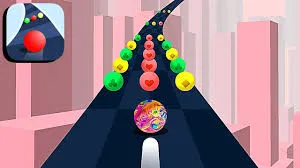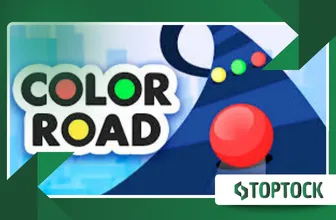Color Road: Roll and Match Colors in a Fast-Paced Arcade Chase

Color Road. The game’s core premise is delightfully simple, which is precisely its strength and immediate draw.
Anúncios
You control a rolling ball moving perpetually forward down a vibrant, winding road composed of multiple lanes.
The objective? Roll over balls of the same color to score points and maintain your speed.
Striking an object of a different color instantly ends the run, demanding both quick reflexes and intense focus from the player.
This immediate feedback loop is the signature of successful casual games.
Anúncios
This formulaic elegance strips away complicated controls, intricate narratives, and lengthy tutorials.
Players grasp the mechanics within seconds of their first attempt, creating an instantly accessible experience.
It is this purity of design that allows the game to function as the perfect five-minute distraction.
The constant pressure of color-switching makes every session an adrenaline-fueled challenge.
How Does the Simple Mechanism Translate into Deep Engagement?
The game leverages human psychology by exploiting our need for immediate challenge and reward.
Matching colors offers a pleasing visual and auditory affirmation, encouraging continuous play.
This system of continuous micro-rewards keeps users hooked, despite the constant threat of failure, a cornerstone of the arcade genre.
The game presents a seemingly endless loop, where each restart promises a chance to beat your previous personal best score.
The road environment is constantly changing its color palette, forcing the player’s eyes to quickly process new visual information.
Imagine trying to sort a deck of cards while riding a rollercoaster—that’s the delightful cognitive load this game imposes.
Color Road requires peak concentration, turning a simple mobile game into a genuine test of reaction time and pattern recognition under duress.
Why Has the Hyper-Casual Model Remained Dominant in 2025?
The hyper-casual genre, to which this title belongs, continues to be a powerhouse in the mobile market, even in 2025.
This success is primarily due to its non-committal nature, appealing directly to the massive audience of “time-filler” gamers.
Read more: Perfect Slices: Chop Vegetables at Lightning Speed Without Mistakes
Players want something fun during short breaks, like a commute or waiting in line. The model also benefits from a robust advertising strategy.
Hybrid monetization, combining rewarded video ads with low-cost in-app purchases, now dominates the landscape for these games.
This approach is highly effective. As a real-world example, while downloads for casual games globally saw a decline of 7% in 2024, the revenue generated from In-App Purchases (IAP) for hybrid-casual titles soared by a staggering 37% year-over-year, according to Sensor Tower.
This shift proves that users are willing to pay to enhance their experience in engaging titles like Color Road.
| Monetization Model | Primary Focus | Player Engagement Type | 2024 Revenue Trend |
| Ad-Supported (Hyper-Casual) | Mass Downloads, High Frequency Ads | Short Sessions, Instant Gratification | Stable to Moderate Decline |
| Hybrid (e.g., Color Road) | Engagement, IAP + Rewarded Ads | Medium Sessions, Progressive Rewards | Significant Growth (+37% IAP) |
| IAP-Heavy (Mid-Core) | Deep Progression, Premium Content | Long Sessions, High Investment | Steady Growth |
This table demonstrates the compelling financial viability of the hybrid model utilized by games like this one.
What Are the Intelligent Design Choices in Color Road?
Beyond the simple gameplay, the game’s success lies in subtle, yet powerful, design decisions. For instance, the developers smartly introduced diverse track patterns.
Sometimes the lanes are straight; other times they feature sharp, unexpected curves or even gaps, forcing the player to master momentum control.
This variety prevents the game from becoming monotonous over time.
++ Paper.io 2: Claim Territory and Outsmart Your Rivals in Real Time
Another intelligent feature is the implementation of speed boosts.
Hitting a perfect streak of same-colored spheres will dramatically increase the ball’s velocity, simultaneously boosting the score multiplier and the difficulty.
This risk-reward mechanic is brilliantly executed. It offers players a choice: play it safe for a guaranteed decent score, or chase the exhilarating, high-speed multiplier for a legendary run.
Can a Simple Arcade Game Truly Offer a Competitive Experience?
Absolutely it can, and this is where the game excels in its longevity.
Though it is fundamentally a single-player experience, the integration of global leaderboards transforms it into a social competition.
Players are not just competing against a digital algorithm; they are battling the best reaction times of players worldwide.
Read here: Esports growth & major tournament highlights
Does a single-color sphere rolling down a track truly inspire that level of dedication? The millions of daily active users suggest an emphatic “yes.”
Consider this analogy: Color Road is the mobile gaming equivalent of a classic track and field sprint.
It’s a pure test of your own limits, but you only know how good you are when you compare your time against the world record.
Every time a player enters the game, they are not just killing time; they are attempting to enter the hallowed top ten of their country or region.
For example, getting a high score requires perfect execution on a tricky sequence, like quickly alternating between blue and red lanes while simultaneously navigating a tight S-curve.

How Can Players Master the Challenges of Color Road?
Mastering the game requires more than just raw speed; it demands anticipation.
Expert players learn to look several seconds ahead of the ball, predicting color changes and planning their trajectory.
They treat the screen not just as a real-time view but as a short-term map.
Color Road veterans often mute the in-game music and focus solely on the visual cues, as external audio can sometimes be a distraction.
Furthermore, a specific tactic involves the “near miss” move.
If the required color is in an adjacent lane, some players briefly graze the opposite, “wrong” color to adjust their angle for a smoother transition to the target lane.
This risky but high-level maneuver showcases the depth hidden within the minimalist design. It’s a game of millimeters, where subtle movements determine massive score differences.
The Enduring Appeal of Arcade Purity
Color Road stands as a testament to the enduring appeal of the arcade chase, proving that innovative simplicity trumps complexity in the mobile world.
It’s a game that knows exactly what it is a challenging, fast-paced, and highly addictive color-matching spectacle.
The developers at Voodoo created a loop that is nearly flawless, making it a definitive title in the casual gaming hall of fame. Its success is a lesson in design efficiency for the entire industry.
Frequently Asked Questions
What is Color Road?
Color Road is a hyper-casual mobile arcade game developed by Voodoo where players control a rolling ball and must match its color with the incoming spheres on a multi-lane, endless track while avoiding different-colored obstacles.
When was Color Road released?
The game was initially released in early 2018, specifically in February, and has since remained a popular title within the hyper-casual gaming ecosystem.
Is the game free to play?
Yes, Color Road is a free-to-play mobile game and primarily utilizes a hybrid monetization model, featuring in-app advertisements and optional in-app purchases for power-ups or ad removal.
How does the game keep track of my score?
Your score increases based on the distance you travel and the number of correct color matches you achieve.
The game also features score multipliers for consecutive perfect matches, encouraging high-risk, high-reward gameplay.
Who is the developer of Color Road?
The game was developed and published by Voodoo, a major global publisher known for creating numerous successful hyper-casual and casual mobile titles.
++ Hot Games










